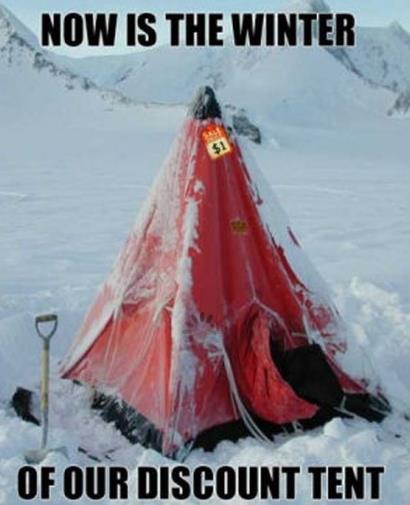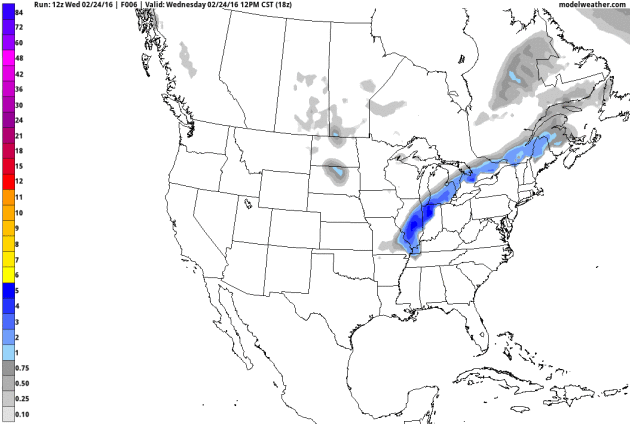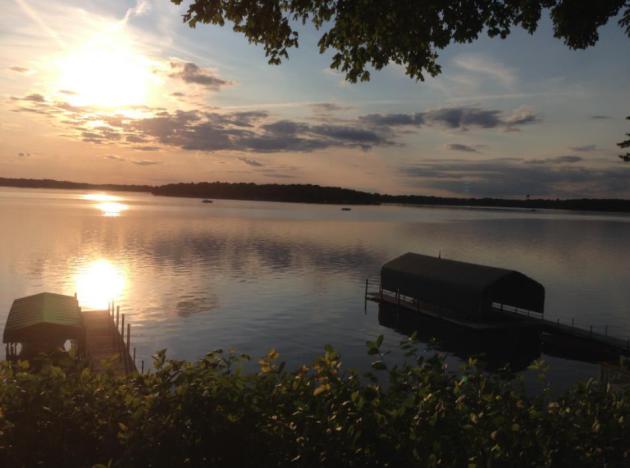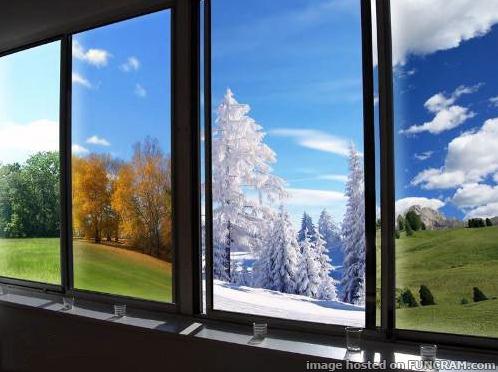30 F. average high on February 24.
29 F. high on February 24, 2015.
February 25, 1934: A late season cold snap produces a bitterly cold low of -46 at Big Falls.

Spring Fever in February? 50s Possible Saturday
"Now is the winter of our discontent..." mused Bill Shakespeare back in 1594. Some things never change.
If you play pond hockey - strap on cross country skis - hide out in your ice house with a fishing rod and cold six-pack - wincing every time you hobble past the cobweb-covered snowmobile in the garage - you might agree it's been a lousy winter.
A few people questioned my "half a winter" description yesterday. 30 inches of snow so far; average for an MSP winter is about 54 inches. 10 subzero nights, to date. Average is 23.
And the mercury may hit 50F Saturday; again Thursday of next week? That's average for early April.
We'll see more fleeting spasms of cold and snow, at least in theory. But the maps look more like late March than late February. A light mix Sunday precedes a puff of cooler air early next week; highs may hold in the 20s Tuesday before the next surge of milder air sweeps north. A tournament storm in March? Perhaps, but at the rate we're going it may wind up as rain.
So far February has brought 1 subzero night in the Twin Cities. Last year February saw 12 nights below zero.
Noon Saturday. Here is NOAA's forecast 2-meter temperature for noon Saturday, showing the 50-degree isotherm closing in on the Twin Cities; 60s possible across the Dakotas. Looks like rough sledding this weekend. Map: AerisWeather.

* 2-meter temperature anomaly (F) courtesy of WeatherBell.
Not Just a Western Problem, Drought Threatens Forests Across U.S. Here's an excerpt from a story at CSMonitor.com: "...While eastern forests have not experienced the types of changes seen in western forests in recent decades, they too are vulnerable to drought and could experience significant changes with increased severity, frequency, or duration in drought,” scientists from 14 institutions, including Duke University, US Department of Agriculture and US Geological Survey, wrote in a paper published Monday in the peer-reviewed journal Global Change Biology. The climate is changing too quickly for trees to adapt to the dry conditions, scientists say..."
Photo credit above: "Many tree species may not be able to expand into more favorable habitats fast enough." Courtesy of USGS
Increasing Drought Threatens Almost All U.S. Forests. Phys.org has a summary of new research findings; here's an excerpt: "Forests nationwide are feeling the heat from increasing drought and climate change, according to a new study by scientists from 14 research institutions. "Over the last two decades, warming temperatures and variable precipitation have increased the severity of forest droughts across much of the continental United States," said James Clark, lead author of the study and an environmental scientist at Duke University..."
Photo credit above: "Drought has left little but skeleton trees in a forest of pinons in the U.S. Southwest." Credit: USGS.
To Prevent Another Dust Bowl, The U.S. Must Sow The Right Seeds. LiveScience and Yahoo Finance have an interesting story - here's a link and excerpt: "...Climate is more important than geography when predicting how well seeds will grow and establish themselves. Seeds don't care where their parents lived if the temperature suits them and if they get the right amount of sunshine and precipitation.
- Timing of seed planting makes a big difference. Year to year, even week to week, variation in weather patterns can affect the restoration success of a burned site.
- The method of planting matters. Blowing seeds from a plane may be a fast way to cover a lot of territory, but it's not that effective. The seeds, dropped from large drums attached to the planes, scatter in the wind, sparsely covering the ground below. Their contact with the earth is also less secure than for seeds planted in furrows by a tractor. As a result, many of the seeds fail to establish themselves, and those few individuals that do will not compete as well in nature as will the densely planted seeds..."
National Geographic ScienceBlogs: Water, Security and Conflict. Violence Over Water in 2015. Is there a connection to what's happening in Syria and Libya? Here's an excerpt from Pacific Institute that raised a few eyebrows: "...Over the past century there has been an increase in the number of reported conflicts over water resources. Part of this increase is certainly due to better reporting in recent years, but growing populations, rising demands for water in water-scarce regions, and weak governance structures and institutions for reducing conflicts at the local and regional level may also be contributing to an increase. In the coming years, far more effort is need to both understand the nature of these risks and to develop diplomatic, economic, and institutional tools for reducing conflicts over water resources. The Pacific Institute will continue to be the leading source for collecting and analyzing information on these challenges..."
Chart credit: "Water conflict chronology events per year, 1930 to 2015." From the Pacific Institute.
Supercomputer Quietly Puts U.S. Weather Resources Back on Top. My oldest son works at Cray, but I would have published this link to a USA TODAY story anyway; here's an excerpt that increases my confidence in NOAA's ability to compete (with ECMWF): "...The brand-new Cray supercomputer — designed, owned and operated by the National Oceanic and Atmospheric Administration (NOAA) — processes 3 quadrillion calculations per second. If that sounds like a lot, it is — you'd need about 12,500 high-end laptops to get close to that kind of power. Still, the supercomputer is merely the 18th fastest in the U.S. and 42nd fastest in the world, Michaud said. NOAA's purchase of the school-bus size device stemmed partly from competition from the top European weather model — better known in some circles by its acronym ECMWF (European Center for Medium-range Weather Forecasting). It predicted Sandy's now infamous and unusual left hook in 2012 days before the top American model — the GFS (Global Forecast System)..."
Photo credit above: "The room where the supercomputer sits must be kept at a temperature of between 69 and 72 degrees." (Photo: Jasper Colt, USAT).



TODAY: Cool and breezy. Winds: NW 10-20. High: 34
THURSDAY NIGHT: Patchy clouds. Low: 20
FRIDAY: Partly sunny and milder. Winds: SW 8-13. High: near 40
SATURDAY: Mild sun, typical for April 1. Winds: SW 10-15. Wake-up: 30. High: 52
SUNDAY: Mild start, then turning cooler, light mix PM hours. Winds: NW 10-20. Wake-up: 35. High: 43
MONDAY: Overcast, mix of light rain/snow. Wake-up: 33. High: 40
TUESDAY: Sunny, cooler than average. Wake-up: 18. High: 28
WEDNESDAY: Dim sun, warming up again. Wake-up: 20. High: 43
Climate Stories....
Earth's Warming is 50x Faster Than When It Comes Out Of An Ice Age. We've already committed to a sea level rise of 5.5 feet, based on the (additional) greenhouse gases we've already pumped into the atmosphere? The rate of warming is one (of many) factors that concern scientists; here's an excerpt from The Guardian: "Recently, The Guardian reported on a significant new study published in Nature Climate Change, finding that even if we meet our carbon reduction targets and stay below the 2°C global warming threshold, sea level rise will eventually inundate many major coastal cities around the world.
20% of the world’s population will eventually have to migrate away from coasts swamped by rising oceans. Cities including New York, London, Rio de Janeiro, Cairo, Calcutta, Jakarta and Shanghai would all be submerged.The authors looked at past climate change events and model simulations of the future..."
Photo credit above: "A parking lot full of yellow cabs is flooded as a result of Superstorm Sandy in Hoboken, NJ. So far we’re already committed to about 1.7 meters (5.5 feet) of eventual sea level rise." Photograph: Charles Sykes/AP.
Photo credit above: "Edison Dardar, an American Indian, tosses a cast net for shrimp in Isle de Jean Charles, La., Friday, Sept. 23, 2011." Image: Gerald Herbert/AP.
* More perspective and analysis on the forced migration due to rising seas and submerged wetlands along Louisiana's coastline from WDSU.
Photo credit above: "Miriam Araujo holds her son Lucas, who was born with microcephaly, in Sao Jose dos Cordeiros, Brazil." Ricardo Moraes / Reuters.

Science Will Help Push Companies Towards a Low-Carbon Future. The smart companies, big and small, are already going on the offensive. Here's an excerpt from The Guardian: "...But most businesses set targets by looking at what could be done through available low-cost energy efficiency opportunities and other reduction activities with a quick payback, such as swapping long-lasting LED lighting for electricity-gulping incandescent bulbs. So while companies may creep away from carbon, they still depend on it. And although most companies are genuinely committed to cutting emissions – not least because their stakeholders hold them accountable for it – they are wary of failing to meet their targets if they aim too high. The good news is greater ambition can lead to innovation..."
Congress Actually Did Something Pretty Great on Climate Change. Some uplifting, encouraging perspective from Mother Jones; here's an excerpt: "In December, Republicans in Congress struck a deal with Democrats to extend a package of tax breaks for wind and solar energy projects. Prior to the deal, things looked bleak. The tax credit for wind had already expired the year before, and the one for solar was set to expire by 2016. So the extension, which came after Democrats agreed to support lifting the long-standing ban on US oil exports, was a big and unexpected win for clean energy—one that will help buoy the industry for the next six years. It could also prove to be one of the most significant actions taken by this Congress to reduce America's carbon footprint, according to a new analysis from the National Renewable Energy Laboratory..." (File image: Wikipedia).
Graphic credit above: "Climate change has helped shift the odds of extreme heat." Credit: WXshift
No comments:
Post a Comment